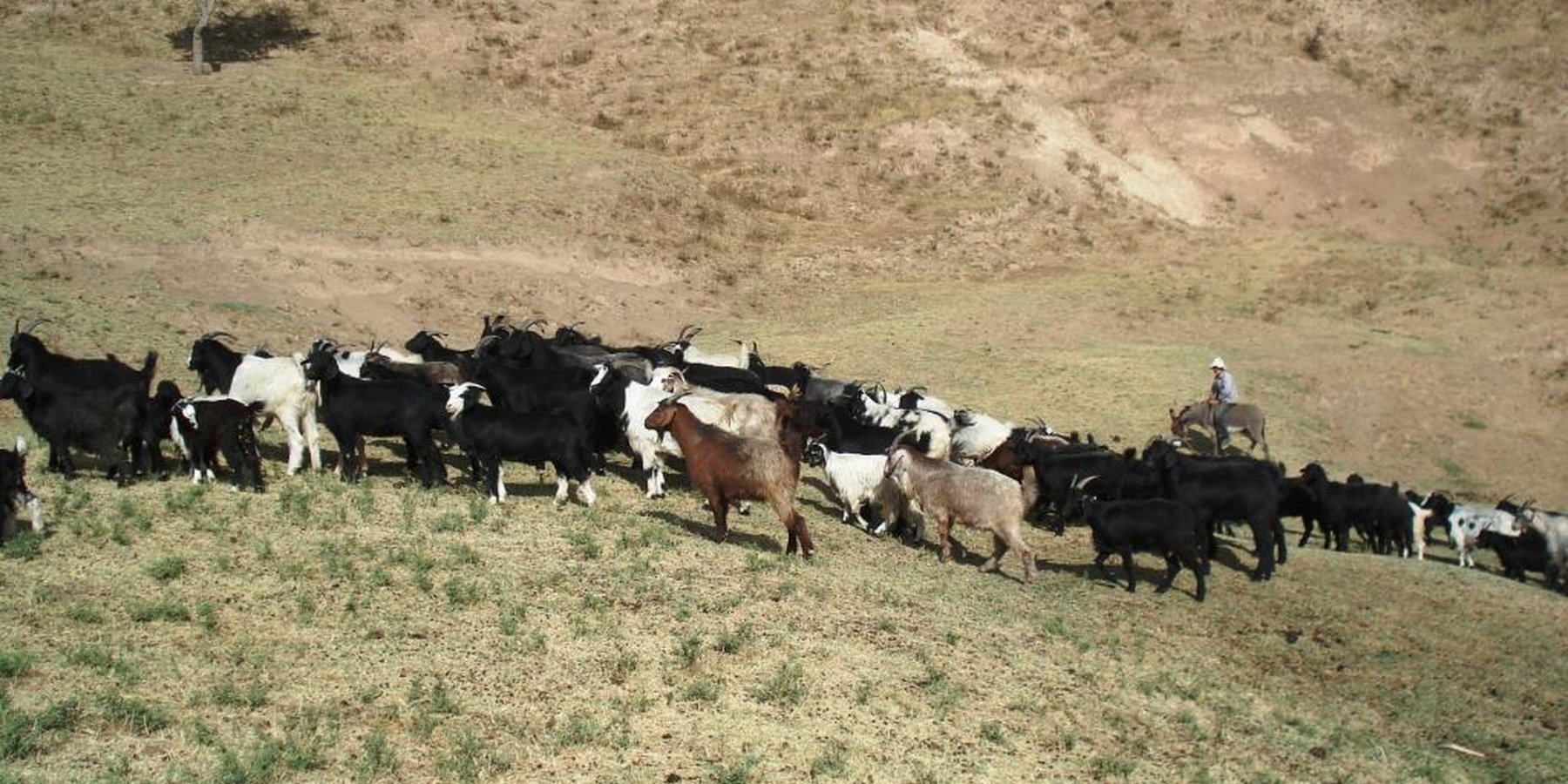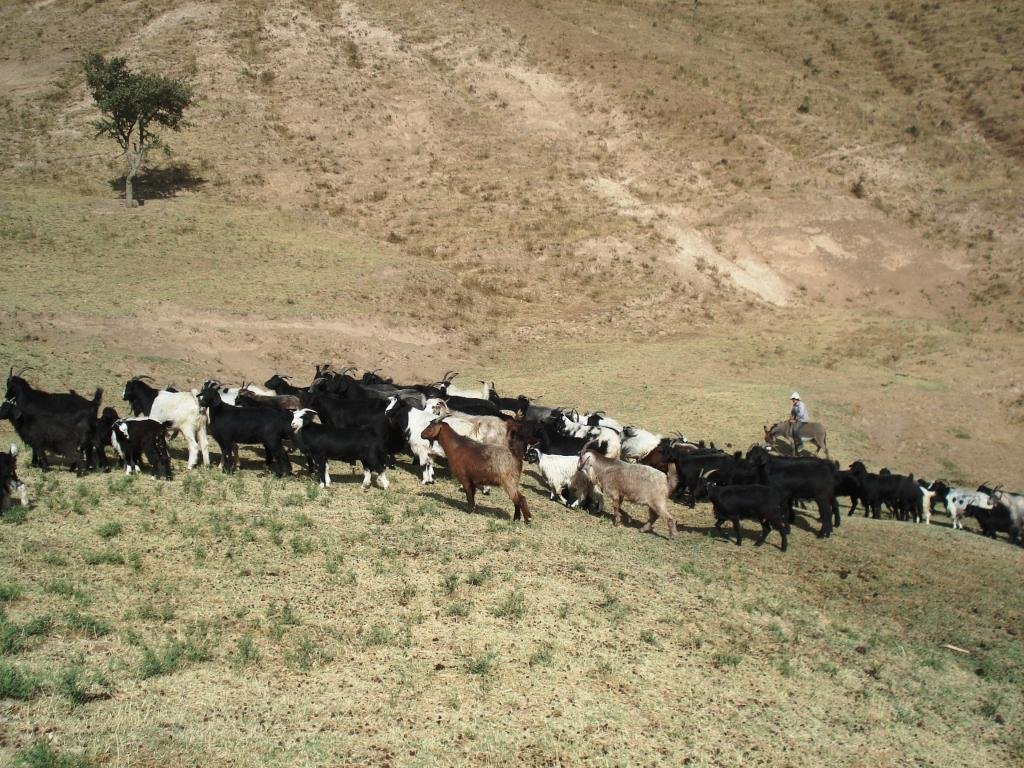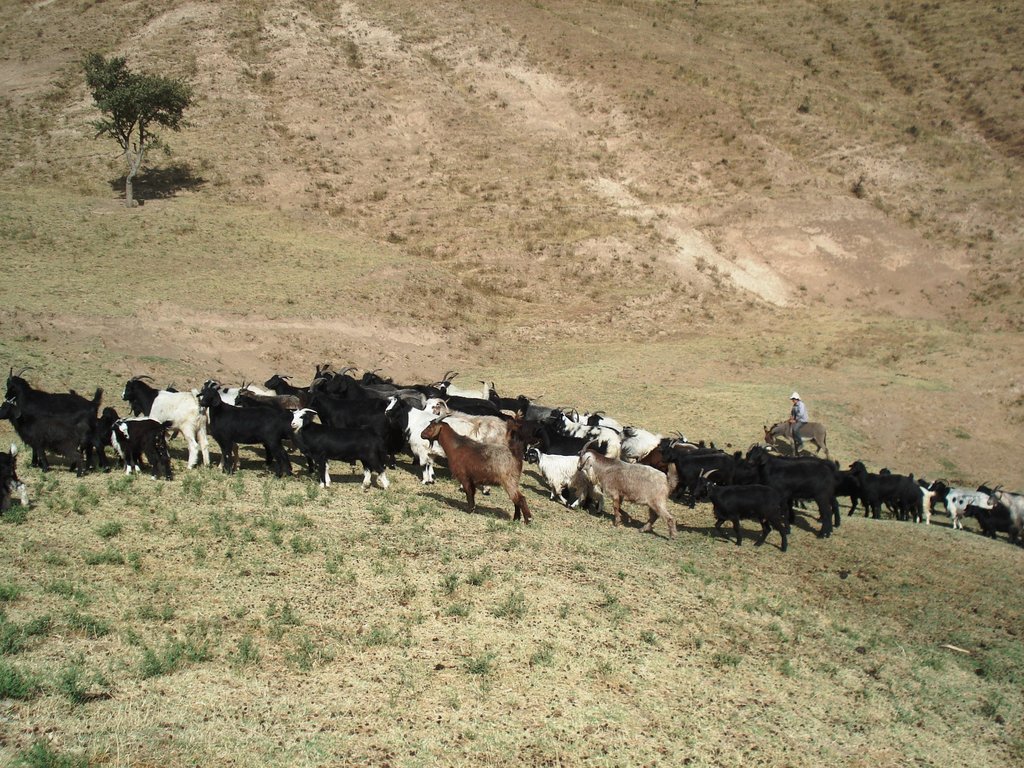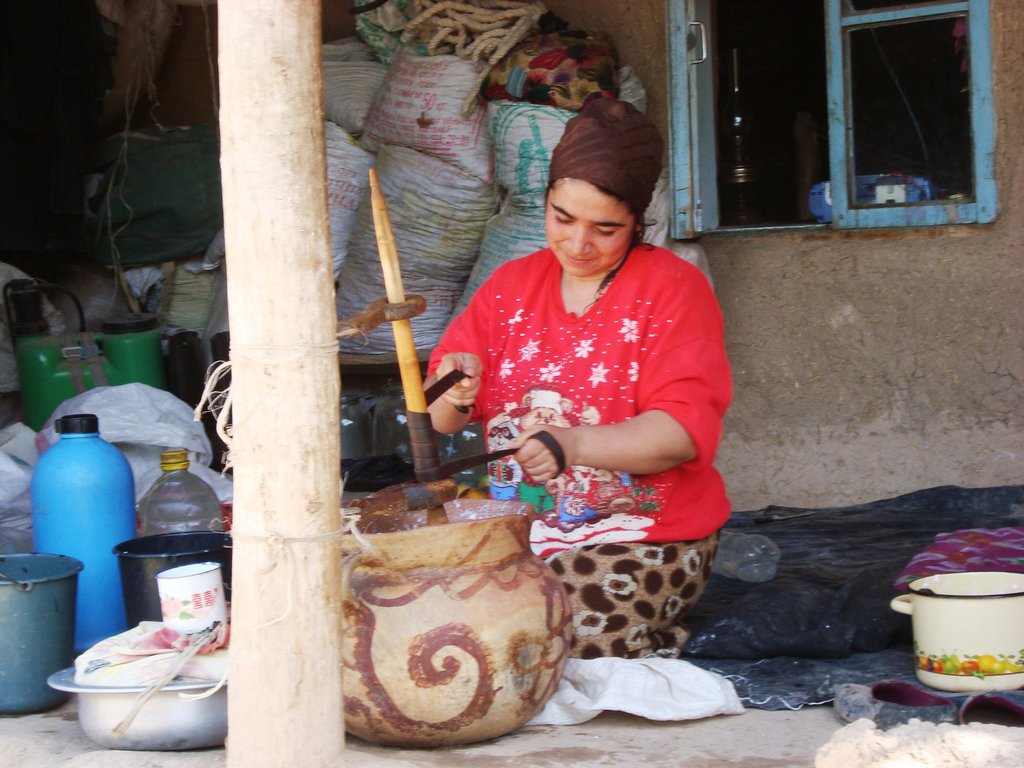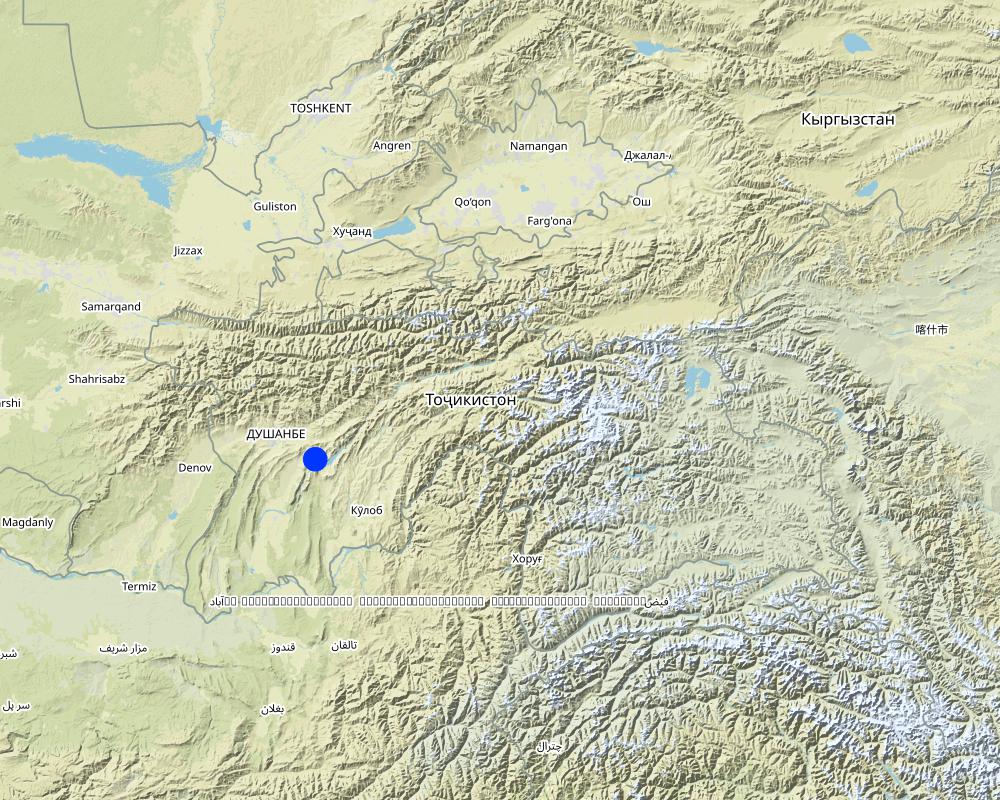Family-based daily herding [Tadjikistan]
- Création :
- Mise à jour :
- Compilateur : Christian Wirz
- Rédacteur : –
- Examinateurs : David Streiff, Joana Eichenberger
approaches_2657 - Tadjikistan
Voir les sections
Développer tout Réduire tout1. Informations générales
1.2 Coordonnées des personnes-ressources et des institutions impliquées dans l'évaluation et la documentation de l'Approche
Nom du ou des institutions qui ont facilité la documentation/ l'évaluation de l'Approche (si pertinent)
CDE Centre for Development and Environment (CDE Centre for Development and Environment) - Suisse1.3 Conditions relatives à l'utilisation par WOCAT des données documentées
Quand les données ont-elles été compilées (sur le terrain)?
20/08/2008
Le compilateur et la(les) personne(s) ressource(s) acceptent les conditions relatives à l'utilisation par WOCAT des données documentées:
Oui
1.4 Références au(x) questionnaire(s) sur les Technologies de GDT
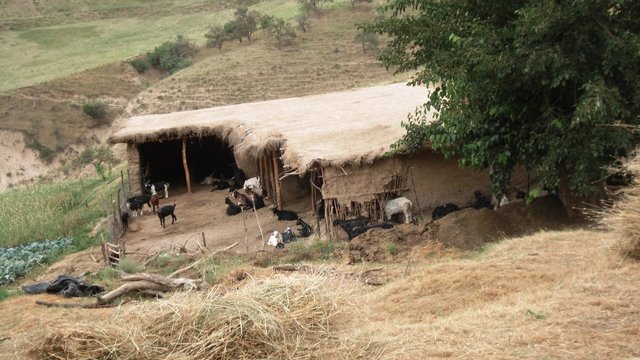
Reduced livestock numbers [Tadjikistan]
The grasslands are used as pastures by a reduced number of livestock belonging to an individual land user.
- Compilateur : Christian Wirz
2. Description de l'Approche de GDT
2.1 Courte description de l'Approche
Private herding of 50 goats by the land user and his sons.
2.2 Description détaillée de l'Approche
Description détaillée de l'Approche:
Aims / objectives: The most important objective for the land user is to make a living for his family (himself, his wife, his sons and their families) by means of simple work, without taking money from others that does not belong to him (without taking bribes). Animal husbandry is an important part of his multistrategy (orchard, kitchen garden, haymaking, grazing). He wants his animals to be fat and healthy and measures the success of his work by the prices obtained on the cattle-market. Further, he does not want that animals damage pastures by too high numbers or too early grazing. For example, vegetation cover is important for him, because it is a protection of soils against frost, it is the best reservoir of seeds and it provides dung for oither plants
Methods: The most important method is is the land user's own initiative, since administration reveals to be a handicap rather than a help. The land user understands himself as someone who relfects on problems and searches for solutions. As an example he mentions the visible damages caused especially by cows if they are led to the pastures too early. He does not lead his cows to the pastures before May because of this and he recommends the village to do so, too, for the village herds. For him, it is necessary to learn from the environment and to respect it. He is also convinced that in the new economic reality after the breakdown of Soviet Union, initiative and entrepreneurial spirit are necessary for success.
Stages of implementation: After renting land for the implementation of an orchard, building a hut and cultivating a garden, he bought a herd. This means that for him breakdown of USSR marks the beginning of his 'Self-made man' approach.
Role of stakeholders: Every family member should contribute to the success of the family enterprise.
2.3 Photos de l'approche
2.5 Pays/ région/ lieux où l'Approche a été appliquée
Pays:
Tadjikistan
Région/ Etat/ Province:
Region of Republican Subordination
Autres spécifications du lieu :
Faizabad
Map
×2.6 Dates de début et de fin de l'Approche
Indiquez l'année de démarrage:
1991
2.7 Type d'Approche
- initiative/ innovation récente locale
2.8 Principaux objectifs de l'Approche
The Approach focused mainly on other activities than SLM (Assuring livestock nutrition, minimising labour input for herding. Still, conservation is also important.)
The choice to have an own herd, separated from the village herd and with the daily obligation to send a family member for herding is mainly based on productivity and animal health: Besides having fatter animals on these more distant pastures it permits the land user to keep billy goats separately from the females to avoid having goatlets before the middle of March. This is important as the goatlets might die because of the low temperatures. In village herds animals always stay together. In addition pastures in the hills around his land are better than those close to villages.
The SLM Approach addressed the following problems: Especially during civil war the main challenge was survival. This means, that in insecure times (that still continue to a certain degree) it was necessary to escape the chaos of war, which was best possible by this self-sufficient system.
2.9 Conditions favorisant ou entravant la mise en œuvre de la(des) Technologie(s) appliquée(s) sous l'Approche
normes et valeurs sociales/ culturelles/ religieuses
- entrave
Jealousy of some villagers led to burning down a part of his orchard.
Treatment through the SLM Approach: Trees were planted again. Since then, nothing happened anymore.
cadre juridique (régime foncier, droits d'utilisation des terres et de l'eau)
- entrave
Even if he has a farmer's association with land that he can cultivate autonomously, administration regularly asked him for money to have clear land tenure.
Treatment through the SLM Approach: Paying for ones rights is unavoidable.
The existing land ownership, land use rights / water rights moderately hindered the approach implementation Even if the land reforms after independance made it possible to build up a farmer's association and to rent land, its slow implementation and the partly unclear land tenure make it difficult to plan business. For example, planting trees for rehabilitation would require the security that the returns by improved pastures would profit the land user. As a further example, the land user would have liked to start a factory with mineral water, but his rights for the use of water are unclear and he is
3. Participation et rôles des parties prenantes impliquées dans l'Approche
3.1 Parties prenantes impliquées dans l'Approche et rôles
- exploitants locaux des terres / communautés locales
The land user with his family
Traditionally, herding is a matter of men, whereas the work in the kitchen, together with the production of butter, cream and curd cheese is done by women.
3.2 Participation des exploitants locaux des terres/ communautés locales aux différentes phases de l'Approche
| Participation des exploitants locaux des terres/ communautés locales | Spécifiez qui était impliqué et décrivez les activités | |
|---|---|---|
| initiation/ motivation | auto-mobilisation | |
| planification | auto-mobilisation | |
| mise en œuvre | auto-mobilisation | |
| suivi/ évaluation | aucun | |
| Research | aucun |
3.4 Prises de décision pour la sélection de la Technologie/ des Technologies
Indiquez qui a décidé de la sélection de la Technologie/ des Technologies à mettre en œuvre:
- les exploitants des terres seuls (auto-initiative)
Expliquez:
The land user bought the land and built up his own livelihood by himself, together with his family.
Decisions on the method of implementing the SLM Technology were made by by land users* alone (self-initiative / bottom-up). Even if in the beginning Soil Institute was interested in research activities on his land, this did not take place, so that he bases all his decisions on his own knowledge and experience.
4. Soutien technique, renforcement des capacités et gestion des connaissances
4.1 Renforcement des capacités/ formation
Une formation a-t-elle été dispensée aux exploitants des terres/ autres parties prenantes?
Non
4.2 Service de conseils
Les exploitants des terres ont-ils accès à un service de conseils?
Non
4.4 Suivi et évaluation
Le suivi et l'évaluation font ils partie de l'Approche? :
Oui
Commentaires:
bio-physical aspects were ad hoc monitored by land users through observations; indicators: Moisture of vegetation, signs of erosion.
There were no changes in the Approach as a result of monitoring and evaluation: None
There were no changes in the Technology as a result of monitoring and evaluation: None
4.5 Recherche
La recherche a-t-elle fait partie intégrante de l’Approche?
Non
5. Financement et soutien matériel externe
5.1 Budget annuel de la composante GDT de l'Approche
Si le budget annuel précis n'est pas connu, indiquez une fourchette:
- < 2 000
Commentez (par ex. principales sources de financement/ principaux bailleurs de fonds):
Approach costs were met by the following donors: local community / land user(s): 100.0%
5.2 Soutiens financiers/ matériels fournis aux exploitants des terres
Les exploitants des terres ont-ils reçu un soutien financier/ matériel pour la mise en œuvre de la Technologie/ des Technologies?
Non
5.3 Subventions pour des intrants spécifiques (incluant la main d'œuvre)
Si la main d'œuvre fournie par les exploitants des terres était un intrant substantiel, elle était:
- volontaire
Commentaires:
Herding is not rewarded by anyone (voluntary labour).
5.4 Crédits
Des crédits ont-ils été alloués à travers l'Approche pour les activités de GDT?
Non
6. Analyses d'impact et conclusions
6.1 Impacts de l'Approche
Est-ce que l'Approche a aidé les exploitants des terres à mettre en œuvre et entretenir les Technologies de GDT?
- Non
- Oui, un peu
- Oui, modérément
- Oui, beaucoup
It helped in the sense of allowing the land user to develop and implement a herding system by himself. It only helped little because the main reason for having less erosion than in other places is the lower accessibility.
Est-ce que l'Approche a autonomisé les groupes socialement et économiquement défavorisés?
- Non
- Oui, un peu
- Oui, modérément
- Oui, beaucoup
Est-ce que l'Approche a amélioré les questions foncières et des droits d'utilisation qui entravent la mise en œuvre des Technologies?
- Non
- Oui, un peu
- Oui, modérément
- Oui, beaucoup
The fact of being able to graze only slightly used village pastures without paying additional rent fees is positive.
Did other land users / projects adopt the Approach?
- Non
- Oui, un peu
- Oui, modérément
- Oui, beaucoup
The land user did not mention anyone else with a similar herding system. It might only make sense to have an own herd daily grazing in a more or less fix area under the circumstances given: low accessibility for the village herd and a completely self-sufficient family-enterprise.
Did the Approach lead to improved livelihoods / human well-being?
- Non
- Oui, un peu
- Oui, modérément
- Oui, beaucoup
The prices achieved by this land user for a sold animal are far higher than those for an average animal of a village herd. And the animals are fatter, thus providing for more food. At the same time th
Did the Approach help to alleviate poverty?
- Non
- Oui, un peu
- Oui, modérément
- Oui, beaucoup
The land user was already well-situated in Soviet times, so the additional wealth is negligible.
6.2 Principale motivation des exploitants des terres pour mettre en œuvre la GDT
- augmenter la rentabilité/ bénéfice, rapport coûts-bénéfices
This method allows high returns (fat animals) with minimal costs.
- prestige, pression sociale/ cohésion sociale
A humble man works much to leave his children remaining values, i.e. good pastures.
6.3 Durabilité des activités de l'Approche
Les exploitants des terres peuvent-ils poursuivre ce qui a été mis en œuvre par le biais de l'Approche (sans soutien extérieur)?
- oui
6.4 Points forts/ avantages de l'Approche
| Points forts/ avantages/ possibilités du point de vue de l'exploitant des terres |
|---|
| Having land that he can use alone (only garden and orchard) or at least quite independently (pastures) is an advantage for him. (How to sustain/ enhance this strength: Giving him the right to use the pastures as a part of his farmer's association would be an interesting option for him.) |
| Because his approach is based on observations, the land user has a good knowledge of the state of environment and especially of livestock. |
| There is a potential of more fodder-production (esparset, lucerne) thanks to the rented land. (How to sustain/ enhance this strength: This might enable him to keep more animals, which is his objective.) |
| Points forts/ avantages/ possibilités du point de vue du compilateur ou d'une autre personne ressource clé |
|---|
| It combines a reasonable use of available workforce with minimal labour inputs, for instance by leaving the cows on the pastures without a herder. (How to sustain/ enhance this strength: Continuity is given thanks to both sons' decision to continue the project of their father with their families) |
| It is based on the reflected, autonomous decisions of a land user with a good education. (How to sustain/ enhance this strength: Education of sons and grandchildren is important for the land user.) |
6.5 Faiblesses/ inconvénients de l'Approche et moyens de les surmonter
| Faiblesses/ inconvénients/ risques du point de vue du compilateur ou d'une autre personne ressource clé | Comment peuvent-ils être surmontés? |
|---|---|
| No systematical monitoring and no research on the efficiency of this herding system are carried out on the land user's land. | Collaboration with the soil institute might be interesting and might be facilitated by the land user's past function as research coordinator of this institute . |
| No clear land use rights and charges defined in a possibly new legal situation (semiprivate use of pastures). | Land reforms must define if and under which conditions pastures can be rented by privates. |
| No research or systematical monitoring exist in the study-area for this herding system | Collaboration with soil institute, whose former brigadier the land user was. |
Liens et modules
Développer tout Réduire toutLiens

Reduced livestock numbers [Tadjikistan]
The grasslands are used as pastures by a reduced number of livestock belonging to an individual land user.
- Compilateur : Christian Wirz
Modules
Aucun module trouvé


